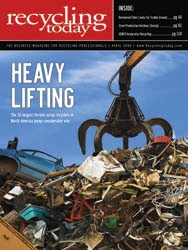Recyclers confronted with sluggish markets may have little to be cheerful about currently, as both volumes and prices have been low in the first quarter of 2009 compared to the previous few years.
Throughout most of this decade, however, recyclers have had the opportunity to operate in a climate of strong revenue and positive cash flow.
Those companies that have moved from the boom years to the slower climate of today in a solid cash position or with strong credit-worthiness may be in great position to take advantage of tax breaks being granted in 2009 to buyers of capital equipment.
SHOPPING LIST
Most recycling equipment makers have benefited this decade from brisk sales to recycling companies that have either added to their processing capacity or upgraded to newer technology.
Recyclers who wanted to buy equipment earlier this decade often faced a waiting period, as many vendors exceeded their production capacity.
Another impediment to some equipment purchases during the boom cycle was a hesitation to interfere with production and output. It’s always painful to shut down production at a manufacturing plant, but especially so when orders are up and margins are good.
Companies that find themselves with an equipment shopping list this year may be able to take advantage of several temporary tax measures that have been enacted at the federal level.
One of the most significant ones is an extension of the one-year 50 percent depreciation tax break that capital equipment purchasers also enjoyed in 2008.
This major write-off possibility has been extended throughout 2009 as part of the 2009 American Recovery and Reinvestment Act (ARRA) , which was signed into law in February. (The ARRA is commonly referred to as the economic stimulus package.)
The 50 percent depreciation policy for 2009, known as Sec. 1201 of the ARRA, presents several potential benefits for equipment buyers:
•
It allows first-year depreciation of 50 percent of the purchase cost on applicable capital equipment.•
Equipment purchases could potentially allow companies making these purchases to cut their 2009 tax bills.•
The policy applies to equipment purchased and placed in service before the end of 2009.•
For Sec. 1201 in particular, the equipment must be new equipment.•
It applies to most heavy industry equipment with an MACRS (Modified Accelerated Cost Recovery System) depreciation period of 20 years or less.ADDED VALUES
Additional aspects of the 2009 ARRA allow business owners to carry annual net losses (known as the NOL carry back period) back into five prior tax years and expands the scope of types of businesses eligible for tax-exempt bond financing.
And Sec. 1202 of the ARRA extends the former Sec. 179 business expensing write-off for both new and used equipment with a value of up to $800,000.
This depreciation allowance targets small businesses. A small business can claim a depreciation amount of up to $250,000 as long as its qualified equipment purchases do not exceed $800,000.
A Web site , www.depreciationbonus.org, established by two trade groups offers details on the 2009 depreciation opportunities as well as describing other aspects of the ARRA that may prove beneficial to business owners.
The Associated Equipment Distributors Inc. (AED) and the National Utility Contractors Association (NUCA) refer to the site as a "one-stop Web clearinghouse for information about the capital incentives in the 2009 American Recovery and Reinvestment Act."
The site contains a disclaimer that its content "should not be construed as tax advice or as a promise of potential tax savings or reduced tax liability." It also advises, "For more information about the depreciation bonus, contact your tax professional or visit the Internal Revenue Service Web site (www.irs.gov)."
The site provides both descriptions of the ARRA’s potential benefits as well as, in some cases, examples of how they might work.
Regarding the extension of the Section 179 expensing extension, the site notes, "For purposes of the Section 179, qualifying property is generally depreciable tangible personal property that is purchased for use in the active conduct of a trade or business."
The site also offers the following example: "Corporation X purchases and places in service machinery (five-year property) in its calendar 2009 tax year having a cost of $650,000, which will be subject to the half-year convention. Corporation X will elect to expense $250,000 under Sec. 179, leaving the machinery with a remaining depreciable basis of $400,000. Applying the bonus depreciation provided by the Act, Corporation X is entitled to a further deduction in 2009 of $200,000 (50 percent of $400,000), leaving the machinery with a remaining depreciable basis of $200,000. Standard first-year depreciation for five-year property under the half-year convention is 20 percent, providing Corporation X with further depreciation on the machinery of $40,000."
The site continues, "Accordingly, Corporation X is entitled to a total expense and depreciation deduction of $490,000 in 2009 on its $650,000 machinery. The remaining $160,000 cost of the property is recovered after 2009 under applicable rules for computing depreciation."
Notes the site, "By increasing a company’s tax deductions in 2009, the asset expense election and bonus depreciation help trim tax bills in the short term. However, because there will be less to depreciate in the future, the company’s tax bill in later years may be higher."
AED and NUCA also combined on a study in the summer of 2008 to look at the effect that the depreciation bonus was having on equipment purchases at that time.
Among its findings: "The ESA’s capital investment incentives have had a positive impact on utility contractor equipment purchasing," the groups stated on July 30, 2008. "Approximately one-third of the survey respondents said they had purchased equipment in the first half of 2008 to take advantage of the depreciation bonus (35 percent) and/or the increased Section 179 expensing levels (32 percent)."
At that time, the trade groups also predicted, "Extending the depreciation bonus and increased Section 179 expensing levels through the end of 2009 would provide additional economic stimulus next year."
Their reasoning: "More than three-quarters of survey respondents said that if the ESA’s capital investment incentives were extended, they would be more likely to buy additional equipment in 2009. Seventy-six percent said they would be more likely to buy equipment next year if the depreciation bonus was extended and 77 percent said the same about the increased Section 179 expensing levels."
Makers of recycling equipment cannot necessarily expect the same response from their customers, but they will almost certainly remind them of the incentives.
The author is editor in chief of Recycling Today and can be contacted at btaylor@gie.net.

Explore the April 2009 Issue
Check out more from this issue and find your next story to read.
Latest from Recycling Today
- Aqua Metals secures $1.5M loan, reports operational strides
- AF&PA urges veto of NY bill
- Aluminum Association includes recycling among 2025 policy priorities
- AISI applauds waterways spending bill
- Lux Research questions hydrogen’s transportation role
- Sonoco selling thermoformed, flexible packaging business to Toppan for $1.8B
- ReMA offers Superfund informational reports
- Hyster-Yale commits to US production





